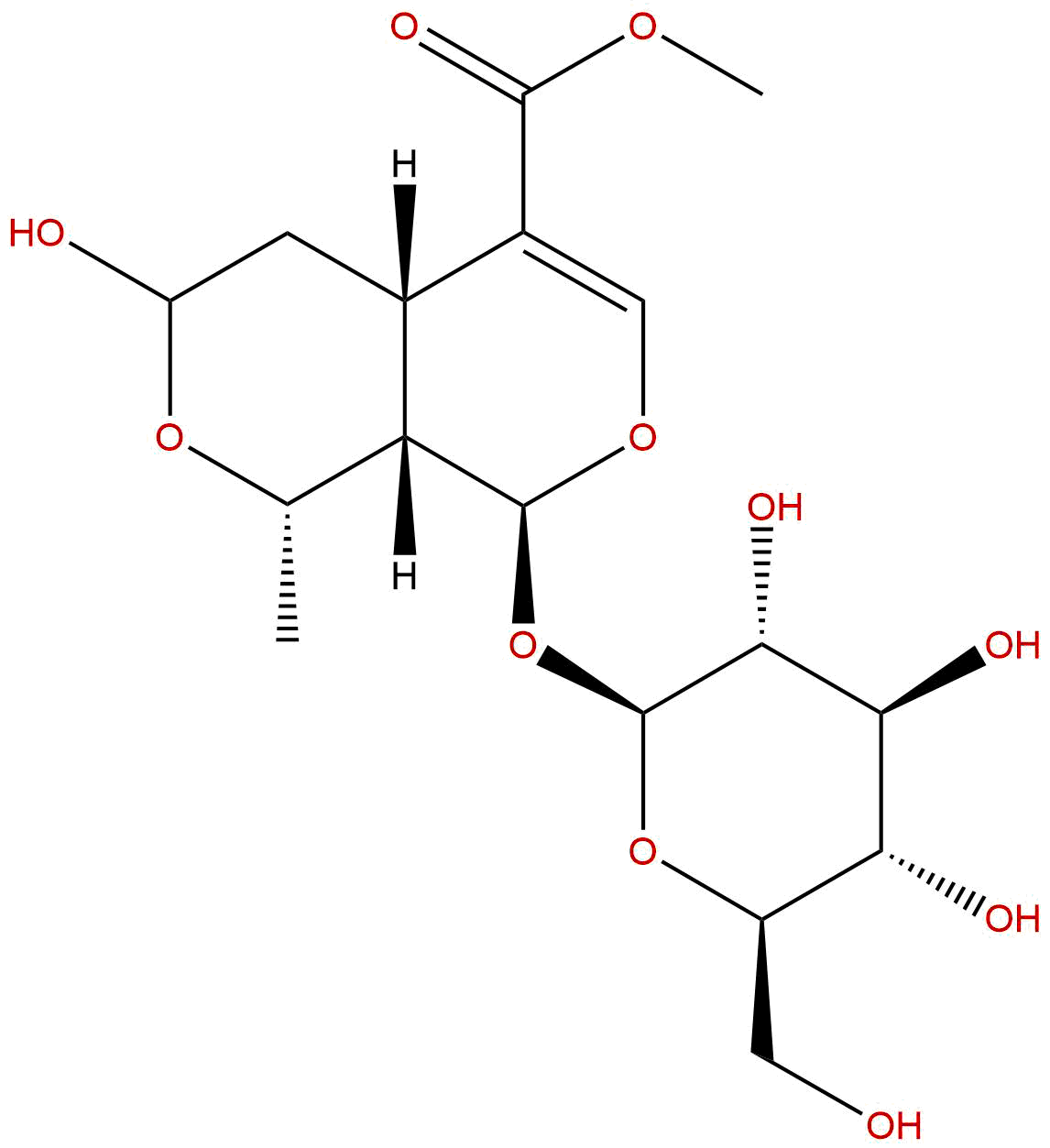
MorronisideCAS No.:25406-64-8 |
||||||||||
 |
|
|
||||||||

| Catalogue No.: | BP0960 |
| Formula: | C17H26O11 |
| Mol Weight: | 406.384 |
| Botanical Source: | Cornus officinalis Sieb.et Zucc. |
Product name: Morroniside
Synonym name:
Catalogue No.: BP0960
Cas No.: 25406-64-8
Formula: C17H26O11
Mol Weight: 406.384
Botanical Source: Cornus officinalis Sieb.et Zucc.
Physical Description:
Type of Compound: Iridoids
Purity: 95%~99%
Analysis Method: HPLC-DAD or/and HPLC-ELSD
Identification Method: Mass, NMR
Packing: Brown vial or HDPE plastic bottle
Storage: Store in a well closed container, protected from air and light. Put into refrigerate or freeze for long term storage.
Whenever possible, you should prepare and use solutions on the same day. However, if you need to make up stock solutions in advance, we recommend that you store the solution as aliquots in tightly sealed vials at -20℃. Generally, these will be useable for up to two weeks.
The product could be supplied from milligrams to grams
Inquire for bulk scale.
Description:
Morroniside has therapeutic effects on diabetic angiopathies, renal damage, lipid metabolism and inflammation and bone resorption. Morroniside can notably protect the brain from damage induced by focal cerebral ischemia which might be related to morroniside antioxidant and anti-apoptotic properties in the brain.Morroniside can decrease the level of cycloxygenase(Cox) and it may be the mechanism of morroniside on inhibiting the platelet aggregation induced by ADP in rabbits.
References:
Can J Physiol Pharmacol. 2006 Dec;84(12):1267-73.
Morroniside and loganin extracted from Cornus officinalis have protective effects on rat mesangial cell proliferation exposed to advanced glycation end products by preventing oxidative stress.
Advanced glycation end products (AGE) are involved in the alterations of renal mesangial cell (MCs) growth, a feature of early stages of diabetic nephropathy (DN).
METHODS AND RESULTS:
We postulate that Morroniside and loganin, 2 components extracted from Cornus officinalis, may ameliorate the detrimental effects of AGE-induced MCs proliferation by preventing oxidative stress. Rat MCs cultured in AGE milieu were treated with Morroniside and loganin. Results showed that Morroniside and loganin inhibited AGE-induced MC proliferation as measured by 3-(4,5-dimethylthiazol-2-yl)-2,5-diphenyltetrazolium bromide (MTT) method. Fluorescence microscopy revealed that the Morroniside and loganin improved the morphological changes of MCs. Flow cytometric analysis showed that Morroniside and loganin inhibited the cell cycle of rat MCs. Furthermore, the level of reactive oxygen species was significantly reduced, and the activities of superoxide dismutase and glutathione peroxidase were markedly increased, whereas the level of malondialdehyde was not significantly reduced.
CONCLUSIONS:
These results suggest that Morroniside and loganin regulate MC growth by preventing oxidative stress. Thus, this study provides a molecular basis for the use of Morroniside and loganin in the early stages of DN.
Eur J Pharmacol. 2014 Sep 5;738:214-21.
Promoting neurogenesis via Wnt/β-catenin signaling pathway accounts for the neurorestorative effects of morroniside against cerebral ischemia injury.
Ischemic stroke is a leading cause of mortality and permanent disability in adults worldwide. Neurogenesis triggered by ischemia in the adult mammalian brain may provide insights into stroke treatment. Morroniside is an active component of sarcocarp of C. officinalis that have shown neuroprotective effects. The aim of the present study is to test whether Morroniside promotes neurogenesis via Wnt/β-catenin signaling pathway for brain recovery in a rat model of focal cerebral ischemia.
METHODS AND RESULTS:
Morroniside was administered intragastrically once daily at the concentrations of 30, 90 and 270 mg/kg for 7 days post-ischemia. Neurological functions were detected by Ludmila Belayev score tests. Endogenous neural stem cells responses were investigated with immunofluorescence staining of Ki-67 and Nestin to identify the neurogenesis in the subventricular zone (SVZ). The expression of proteins involved in and related to Wnt/β-catenin signaling pathway was detected by western blotting analysis. Morroniside significantly promoted neurogenesis for brain recovery 7 days post-ischemia. Increased expression of Wnt 3a, β-catenin and T-cell transcription factor-4 (Tcf-4), along with activation of downstream transcription factors Pax6 and neurogenin2 (Ngn2), indicated that the neurorestorative effects of Morroniside may be associated with Wnt/β-catenin signaling pathway.
CONCLUSIONS:
These data provide support for understanding the mechanisms of Morroniside in neurorestorative effects and suggest a potential new strategy for ischemic stroke treatment.
J Cell Mol Med. 2015 Aug;19(8):1877-86.
Protein kinase B and extracellular signal-regulated kinase contribute to the chondroprotective effect of morroniside on osteoarthritis chondrocytes.
Despite extensive studies on the multifaceted roles of Morroniside, the main active constituent of iridoid glycoside from Corni Fructus, the effect of Morroniside on osteoarthritis (OA) chondrocytes remains poorly understood.
METHODS AND RESULTS:
Here, we investigated the influence of Morroniside on cultured human OA chondrocytes and a rat experimental model of OA. The results showed that Morroniside enhanced the cell viability and the levels of proliferating cell nuclear antigen expression (PCNA), type II collagen and aggrecan in human OA chondrocytes, indicating that Morroniside promoted chondrocyte survival and matrix synthesis. Furthermore, different doses of Morroniside activated protein kinase B (AKT) and extracellular signal-regulated kinase (ERK) in human OA chondrocytes, and in turn, triggered AKT/S6 and ERK/P70S6K/S6 pathway, respectively. The PI3K/AKT inhibitor LY294002 or the MEK/ERK inhibitor U0126 attenuated the effect of Morroniside on human OA chondrocytes, indicating that the activation of AKT and ERK contributed to the regulation of Morroniside in human OA chondrocytes. In addition, the intra-articular injection of Morroniside elevated the level of proteoglycans in cartilage matrix and the thickness of articular cartilage in a rat experimental model of OA, with the increase of AKT and ERK activation.
CONCLUSIONS:
As a consequence, Morroniside has chondroprotective effect on OA chondrocytes, and may have the therapeutic potential for OA treatment.